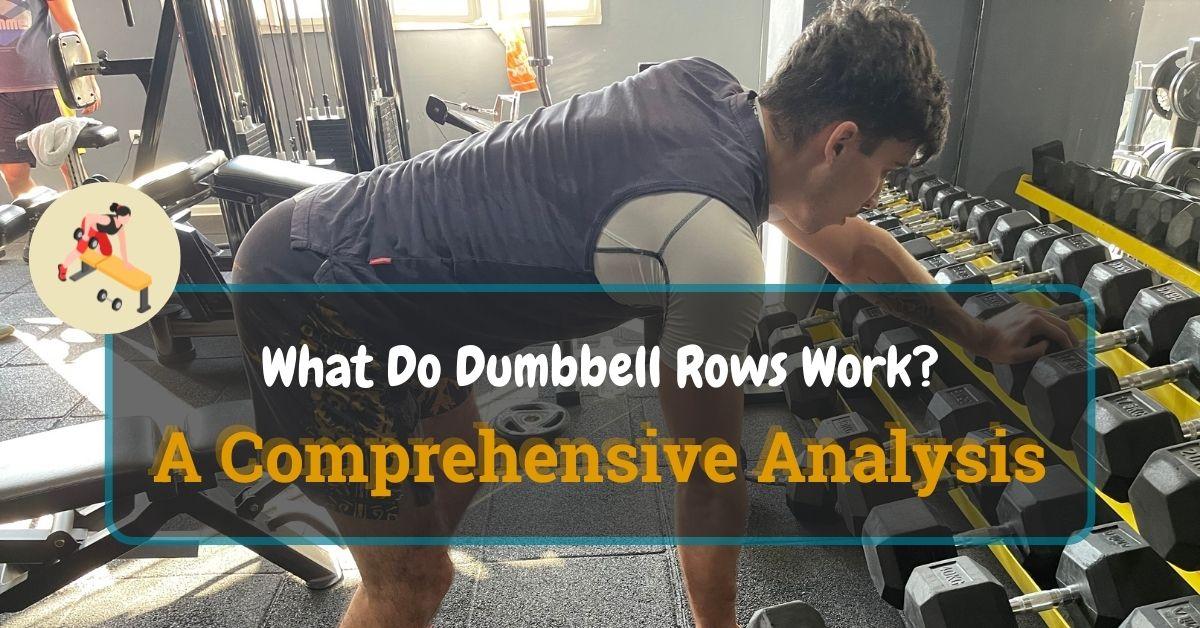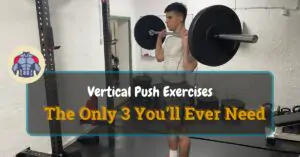Dumbbell rows, a highly versatile and fundamental exercise, are key components of many fitness routines, irrespective of one’s fitness level.
Table of Contents
ToggleWhether you’re a regular gym goer, a fitness enthusiast, or a beginner, understanding the muscle groups targeted by this popular exercise will help you maximize your fitness results and prevent injury.
As a Faculty of Sport and Physical Education student, I undertook a 10-hour research to compile all the necessary information regarding muscle activation during dumbbell rows.
So, what do dumbbell rows work?
Dumbbell rows work latissimus dorsi, rhomboids, trapezius, biceps brachii, brachialis, brachioradialis, erector spinae, and core muscles such as obliques.
However, not all of the muscles engaged in a dumbbell row have the same function, meaning some are prime movers, and some only serve to support the movement.
That’s why you should continue reading below to learn which ones are primary and which are secondary working muscles in the dumbbell rows.
Start Building Your Dream Body Today
Ready to elevate your fitness game without falling into the trap of dull, repetitive routines that just don’t deliver? Imagine sculpting your ideal physique and boosting your health, all while still enjoying life’s pleasures, like those irresistible weekend getaways and your aunt’s legendary cheesecake. With our online fitness and nutrition coaching service, you don’t have to compromise. Dive into a personalized fitness journey that blends perfectly with your lifestyle, not against it. Book your completely free discovery consultation today, and take the first step towards a transformation that doesn’t require giving up the joys of life.

“I was skeptical about online fitness coaching, but Functional Body Savage completely changed my perspective. Vanja and Radomir’s personalized approach and attention to detail have helped me achieve goals I never thought possible. I’m stronger, more confident, and grateful for their guidance.”
Emily Thompson, San Francisco, CA
Learn More About Our Online Coaching ServiceQuick Summary
- Dumbbell rows target several muscles, primarily the latissimus dorsi (lats), rhomboids, and trapezius, but also engage secondary muscles such as the biceps brachii, brachialis, brachioradialis, erector spinae, and core muscles including the obliques.
- Proper form and technique are essential in maximizing the efficiency of the exercise and preventing injury, involving a straight back, slightly bent knees, and slow, controlled movement.
- Dumbbell rows can be incorporated into your workout routine in various ways, and they pair well with other exercises for a full-body workout.
- Several dumbbell row variations can be tried to shift focus on different muscle groups or add variety to your fitness regimen.
Dumbbell Rows Muscles Worked
Upper back muscles working during the traditional dumbbell row exercise can be separated into primary and secondary muscles.
Primary back muscles are responsible for most of the movement, while secondary back muscles often serve as stabilizers or participate in a small portion of the movement.
The Primary Muscles Worked
Primary muscles worked include latissimus dorsi, rhomboids, and trapezius.
These muscles are the prime movers and participate the most during the rowing motion.
Latissimus Dorsi
Often referred to as the “lats,” these are the primary muscles targeted by dumbbell rows.
Located on either side of your back, the lats are responsible for extension, adduction, horizontal abduction, and internal rotation of the shoulder joint.
Strengthening these muscles can improve posture, enhance overall back strength, and contribute to a V-shaped physique.
Rhomboids
These muscles, located in your upper back between your shoulder blades, are significantly worked during a dumbbell row.
They aid in retracting the shoulder blades—crucial for maintaining good posture.
Trapezius
The trapezius is a large muscle extending down the back of the neck and upper spine, with fibers running in multiple directions.
The middle and lower traps are especially engaged in dumbbell rows, helping in scapular retraction and depression.
Secondary Muscles Worked
While the primary focus of the dumbbell row is the back, it’s also an excellent exercise for working several other supporting muscles.
These often serve as fixators or stabilizers during the movement.
Biceps Brachii
Located in the upper arm, the biceps assist with the pulling motion of the row.
While not the primary muscle worked, the dumbbell row can still contribute to building stronger, toned biceps.
Brachialis and Brachioradialis
These muscles, located underneath the biceps and in the forearm respectively, assist with elbow flexion during the rowing motion.
Erector Spinae
This group of muscles runs along your spine and works to maintain your posture and protect your back during the rowing motion.
Core Muscles
Your abs, obliques, and lower back are all engaged when performing dumbbell rows, especially if done in a bent-over or plank position.
They help stabilize your body during the exercise, improving your overall balance and core strength.
Technique and Form
Knowing which muscles a dumbbell row works is half the story.
To get the most from this exercise, proper technique and form are crucial.
This will ensure all the targeted muscles are effectively engaged and will also reduce the risk of injury.
Here are some key tips:
- Stand with your feet hip-width apart.
- Bend your knees slightly and hinge forward from your hips, not your waist.
- Keep your back straight. Avoid rounding or arching it.
- Holding a dumbbell in one hand, keep the other hand on a bench for support.
- Pull the dumbbell up towards your chest, keeping your elbow close to your body.
- Slowly lower the dumbbell back down, extending your arm fully.
Dumbbell Rows in Your Workout
Include dumbbell rows into your strength or bodybuilding routine to add variety and target multiple muscle groups simultaneously.
You can pair them with other upper body exercises, such as bench presses and bicep curls, or incorporate them into a full-body workout.
No matter your fitness level, understanding the “why” behind your workouts can make a big difference.
Dumbbell rows, with their wide range of targeted muscles, are a great addition to any fitness regimen.
Remember, it’s always a good idea to consult with a certified personal trainer or physiotherapist to ensure you’re performing exercises correctly, particularly if you’re a beginner or have a pre-existing condition.
Safety and efficiency are paramount in the pursuit of fitness.
Dumbbell Row Variations
Understanding the muscles targeted by dumbbell rows allows us to tweak the exercise to place focus on different areas.
Here are some dumbbell row variations you can consider incorporating into your routine:
Single-Arm Dumbbell Row
This is the standard dumbbell row, performed one arm at a time. It allows for a high degree of focus on each side of the back independently, which can help address any muscle imbalances.
Bent-Over Dumbbell Row
In this variation, you use both arms simultaneously. It’s a time-efficient version that targets the same muscles as the single-arm row, but it requires more core stability.
Plank Row or Renegade Row
The dumbbell renegade row begins in a high plank position, holding a dumbbell in each hand. You perform a row with one arm while maintaining the plank with the other.
This variation targets the same upper body muscles, but also significantly engages the core and lower body, adding a stability challenge to the exercise.
Incline Bench Dumbbell Row
Lying face-down on an inclined bench, you’ll perform the chest supported dumbbell row movement.
The incline bench dumbbell row can be easier on the lower back and allows for strict form, focusing the work on your upper back and shoulder muscles.
Pendlay Row
This explosive version is performed with a barbell from a dead-stop position on each rep, targeting the same muscles but integrating more lower body engagement and power generation.
Programming Dumbbell Rows
When it comes to incorporating dumbbell rows into your fitness routine, it’s essential to balance your workout effectively.
As a pulling exercise, dumbbell rows complement pushing exercises like bench presses and shoulder presses, helping prevent muscle imbalances and maintain postural alignment.
For general strength and muscle growth, aim for 3-4 sets of 8-12 reps of dumbbell rows, adjusting weight to stay within this range.
Beginners might start with lighter weights, focusing on form and control before moving to heavier loads.
For endurance or muscular tone, increase the reps to around 15-20 per set, using lighter weights.
Remember, no matter your goal, quality always trumps quantity—proper form should never be sacrificed for heavier weights or more reps.
FAQs
What Are Dumbbell Rows Good For?
Dumbbell rows are good for getting your back stronger. Exercising your latissimus dorsi, posterior deltoids, teres major, trapezius, and rhomboids ensures building strength, endurance, and power in all pulling movements.
Are Dumbbell Rows Worth Doing?
Yes, dumbbell rows are worth doing. Dumbbell rows are excellent for strengthening your pulling muscles, such as latissimus dorsi, posterior deltoid, and trapezius, which corrects your posture and makes all pulling movements much easier.
Are Dumbbell Rows Necessary?
Yes, dumbbell rows are necessary. Dumbbell or barbell rows are necessary besides bench presses, overhead presses, pull-ups, squats, and deadlifts since they belong to the essential strengthening exercises.
Do Dumbbell Rows Build Thickness?
Yes, dumbbell rows build thickness. Dumbbell rows will effectively build thick and strong back muscles responsible for good posture, strong pulling, and overall spine support.
Are Dumbbell Rows Enough for Lats?
No, dumbbell rows aren’t enough for lats. To exercise your lats fully, you must implement some exercise, such as a pull-up that belongs to the vertical pulling motion.
Are Kettlebells More Functional Than Dumbbells for Rows?
Yes, kettlebells are more functional than dumbbells for rows.
Kettlebells are the most functional gym equipment because they allow for the most significant range of motion at joints and activate more stabilizer muscles.
However, picking the right kettlebell for your home gym may be difficult due to overwhelming choices on the market and the inability to differentiate between the same.
If that is something that borders you, I suggest reading our guide on the best kettlebells for home gym to pick the one that will suit your budget, needs, and personal goals the best.
In the comments below, let me know your thoughts on the bent-over dumbbell row and whether they are as effective as a barbell or kettlebell row.
Start Building Your Dream Body Today
Ready to elevate your fitness game without falling into the trap of dull, repetitive routines that just don’t deliver? Imagine sculpting your ideal physique and boosting your health, all while still enjoying life’s pleasures, like those irresistible weekend getaways and your aunt’s legendary cheesecake. With our online fitness and nutrition coaching service, you don’t have to compromise. Dive into a personalized fitness journey that blends perfectly with your lifestyle, not against it. Book your completely free discovery consultation today, and take the first step towards a transformation that doesn’t require giving up the joys of life.

“I was skeptical about online fitness coaching, but Functional Body Savage completely changed my perspective. Vanja and Radomir’s personalized approach and attention to detail have helped me achieve goals I never thought possible. I’m stronger, more confident, and grateful for their guidance.”
Emily Thompson, San Francisco, CA
Learn More About Our Online Coaching Service




